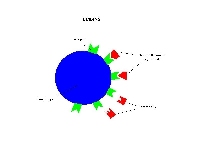| Introduction |
| Recognition of the Immune System |
| Generating Receptor Diversity |
| Affinity Maturation |
| Organizing Principles |
| Possible Architectures |
| Artifical Immune System |
| Summary |
Recognition |
The cells responsible for detection (or recognition) of pathogens in the acquired immune system are the lymphocytes.
Detection of pathogens by lymphocytes
 Figure . Detection is a consequence of binding between
complementary chemical structures.
Figure . Detection is a consequence of binding between
complementary chemical structures.
Lymphoctyes detect or recognize pathogens by binding to them (see figure ). Pathogens are detected when a molecular bond is established between the pathogen and receptors that cover the surface of the lymphocyte. Because of the large size and complexity of most pathogens, only parts of the pathogen, discrete sites called epitopes, get bound to the lymphocyte receptors. A particular receptor will not be able to bind to all pathogens; the more complementary the structures of the epitope and the lymphocyte receptor, the more likely it is that a bond will occur.
A lymphocyte has approximately 100 000 receptors on its surface, but because all of these receptors have the same struture (a lymphocyte is monoclonal), a single lymphocyte can only bind to structurally related epitopes. These structurally related epitopes define the similarity subset that the lymphocyte detects. The number of receptors that bind to pathogens will determine the affinity that the lymphocyte has for a given pathogen. If a bond is very likely to occur, then many receptors will bind to pathogen epitopes, resulting in a high affinity for that pathogen; if a bond is unlikely to occur, then few receptors will bind to epitopes, and the lymphocyte will have a low affinity for that pathogen. Lymphocytes can only be activated by a pathogen if the lymphocyte's affinity for the pathogen exceeds a certain affinity threshold. As the affinity threshold increases, the number of epitope types that can activate the lymphcyte decrease, i.e. the similarity subset becomes smaller. Hence binding - or detection - in the immune system is approximate.
Binding is approximate
Probably because it is too difficult to evolve receptor structures that are precisely complementary to epitopes that have never been encountered before. If precise binding were required, the chances of a random lymphocyte binding to a random epitope would be vanishingly small. An important consequence of approximate binding is that a single lymphocyte can detect a subset of epitopes, which means that fewer lymphocytes are needed to provide protection against the vast variety of possible pathogens.